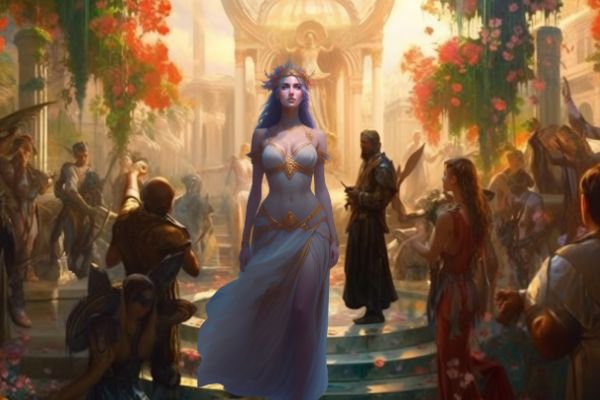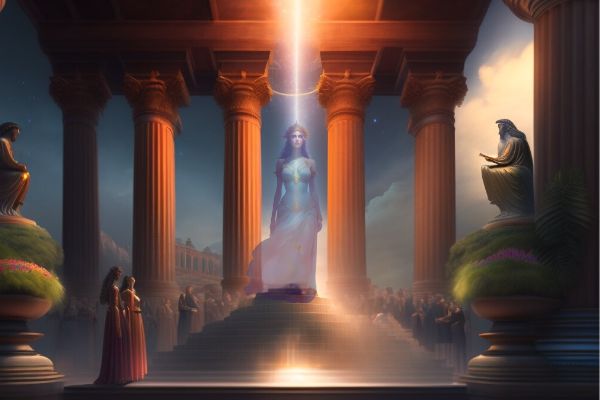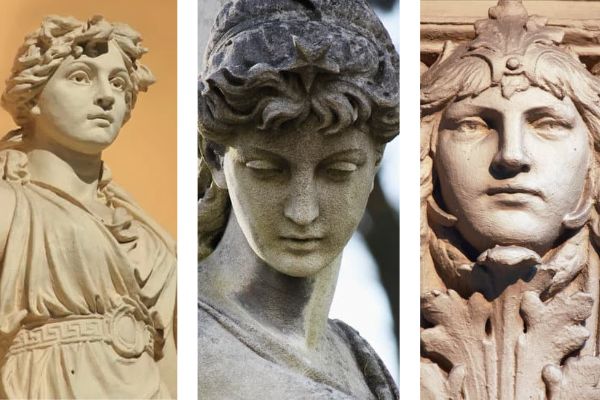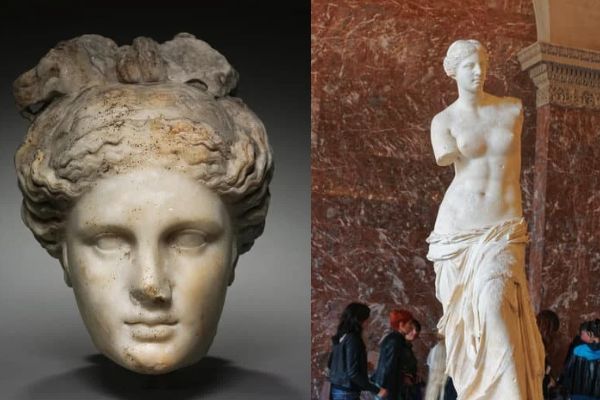Home » Goddess Aphrodite: Facts, Myths, Powers, Personality, Birth…
Goddess Aphrodite: Facts, Myths, Powers, Personality, Birth…
In all the ancient stories about her, Aphrodite is known as the goddess of love and beauty.
Her influence over these two domains made her outrageously popular among the people of ancient Greece.
Even today, she is one of the most searched for Greek goddesses.
In this guide, you’ll get all the important facts about Aphrodite that made her mythology so engaging.
You’ll learn about the divine powers she possessed, what her personality was like, and her dominance over the realm of love.
You’ll also learn the famous story of how goddess Aphrodite was born and how her beauty captured the hearts of all the Greek gods from day one.
Plus, you’ll learn all of the other important things about her like who’s part of her family tree, who was she married to, and what might she look like.
Get ready to let all the Aphrodite facts and intoxicating myths sweep you off your feet.
Who was Goddess Aphrodite in Mythology?

Many know Aphrodite as the goddess of love and stunning physical beauty.
But she was also known for creating desire, passion, and seduction.
She had the ability to captivate the hearts of gods and mortals alike, and her beauty often played a role in the many stories about her.
On top of that, she had the ability to ignite these feelings in others, whether it was romantic love, passionate desire, or the deep bond between friends and family members.
As the goddess of love, Aphrodite would use her charm and beauty to get what she wanted, whether it was to win the affection of a mortal, or to gain the upper hand in a conflict with the other gods.
She had no problem using her powers for a good cause, or to punish those that slighted her.
As you’ll soon see, it was all part of her character and who she was in Greek mythology.
How was Aphrodite Born?

The myth about how Aphrodite was born is primarily found in Hesiod’s “Theogony”.
In this popular myth, she was born from the sea foam that arose from the severed genitals of the god Uranus, who had been castrated by his son Cronus.
As she emerged from the sea, she was fully grown and radiantly beautiful, instantly capturing the hearts of gods and mortals.
In addition to Hesiod’s “Theogony,” Aphrodite’s birth is also mentioned in Homer’s “Iliad,” although the details of her parentage differ.
In Homer’s version, she is described as the daughter of Zeus and the Titaness Dione, highlighting the variations in mythological accounts, even amongst ancient Greeks.
Regardless of how goddess Aphrodite was born or created, she was closely associated with the sea, and was often depicted rising from the waves on a seashell.
Goddess Aphrodite’s Powers

Like her counterparts on Mount Olympus, Aphrodite’s special powers and abilities made her a unique character in Greek mythology.
By exploring her divine abilities and how she used them, we can gain a deeper appreciation for the goddess of love and the undeniable influence she wielded concerning romantic matters.
Here’s a list of Aphrodite’s important powers…
• Powers Over Love – This is her most well-known ability. And her rule over this realm was legendary. She had the ability to inspire feelings of love and attraction in mortals and gods. In many of her stories, she uses this special ability to manipulate things in her favor, or in favor of someone she’s trying to help.
• Power Over Beauty – She also possessed the special powers to bestow beauty on others. She could enhance a person’s physical appearance, as well as their inner qualities, such as charm, charisma, and likeability. The goddess herself was considered the most beautiful deity in Greek mythology.
• Abilities to Seduce – Goddess Aphrodite had a seductive prowess that was unmatched in Greek mythology. She could seduce even the most reluctant individuals by using her beauty, wit, and sensuality to her advantage. As with her other abilities, she was able to pass this one onto others.
Power of Procreation – In some stories, she had the ability to grant or withhold the gift of fertility. Her capacity to foster fertility and procreation made her a central figure in ancient Greek culture. That’s why she was often invoked by those seeking to conceive or ensure a successful childbirth.
• Magic Belt (or Girdle) – This is another tool that added to Aphrodite’s goddess powers and divine capabilities. The belt had the ability to inspire feelings of desire and passion in those who wore it. She used this magical belt on several occasions to manipulate the desires of mortals and gods.
• Ability to Transform People and Objects – She had the ability to transform objects, such as turning a simple rock into a precious gemstone. Or turn a statue into a real person like she did in one of her famous tales. In myth after myth, she is depicted using this ability.
• Always Young – Like most of the other Greek gods and goddesses, it’s assumed that immortality and the ability to stay forever young was one of her capabilities. As the goddess of beauty, staying young and lovely was a given. In most statues and sculptures of her, that’s how she’s presented.
Goddess Aphrodite’s powers were far-reaching and she applied them in both a selfish and unselfish way at times.
That’s part of what makes her story so mesmerizing.
Her skills and divine abilities left a lasting impact on ancient mythology.
Personality of Aphrodite
Aphrodite’s personality is complex and one of the most talked about factors among historians, scholars, and anyone else who studies this goddess.
She was beautiful, passionate, and charming. This made her skilled at seduction.
She bestowed blessings on lovers, guided marriages, and played matchmaker.
But Aphrodite’s personality was not limited to love and harmony.
She had flaws.
For example, she was known for her jealousy, vanity, and fierce competitiveness.
Her seductive allure and vanity caused rivalries among gods and mortals, highlighting her penchant for using her powers in a destructive way.
She was known to use her beauty and irresistible appeal as a tool to get what she wanted.
On top of that, she’s notorious for cheating on her husband with numerous lovers.
From all the stories about her, it’s evident that goddess Aphrodite’s character traits reveal her as a controversial, yet enthralling figure in Greek mythology.
She embodies love, passion, beauty, and grace, but is also associated with seduction, jealousy, and rivalry.
Interesting Facts About Aphrodite
Here are the more noteworthy facts about Aphrodite from Greek mythology.
1. She is an ancient Greek goddess associated with love, beauty, pleasure, and procreation. Her domain also extends to desire and sexual attraction.
2. The Roman equivalent of goddess Aphrodite is Venus. In Roman mythology, she holds similar traits and responsibilities.
3. Her symbols include the dove, rose, myrtle tree, sparrows, and swans. These are often depicted in art and stories related to her.
4. She is often depicted in art as a beautiful woman, usually nude or semi-nude, signifying her domain over beauty and desire. She’s often shown in the company of Eros, the god of love, who is considered her son in some myths.
5. There are two main accounts of Aphrodite’s birth. In the version from Hesiod’s “Theogony,” she was born from the sea foam following the castration of Uranus, the sky god. However, in Homer’s “Iliad,” she is presented as the daughter of Zeus and Dione.
6. Her cult was widespread across the Greek world, but her principal places of worship included the islands of Cythera and Cyprus. Both locations claimed to be her place of birth, resulting in the two epithets for the goddess: Cytherea and Cypria.
7. She was one of the twelve Olympian gods and goddesses who made up the council of the gods. The Olympians were the principal deities of the Greek pantheon.
8. Her festival, the Aphrodisia, was celebrated across Greece but particularly in Athens and Corinth. It involved various rites, including the purifying of her temple, offerings, and possibly ritual prostitution, though this latter element is debated among historians.
9. She is one of the most frequently depicted figures in Greek art, appearing in countless works from the Archaic period (c. 800-500 BC) through to the Hellenistic period (323-31 BC). She is a popular subject in sculpture, painting, and pottery, often shown bathing, dressing, or in scenes of mythological importance.
10. The ancient city of Paphos in Cyprus was a major center for Aphrodite’s worship. It’s here that her famous Sanctuary was located, which was a prominent pilgrimage site during the Classical period of Greece.
11. She was considered the patron goddess of sailors and sea-farers in ancient times, due to the myth of her birth from the sea foam.
12. She was often portrayed with other gods and goddesses associated with love and marriage, such as Hymenaios, the god of weddings, and Peitho, the goddess of persuasion and seduction.
13. In ancient Sparta, she was worshipped under the epithet “Morpho,” a term that signifies “form” or “beauty,” emphasizing her role as the goddess of physical attractiveness.
14. She was closely linked with the concept of “Charis” or Grace. In fact, the Charites or Graces, who served as the attendants of Aphrodite, were the personifications of beauty, charm, and grace.
15. The planet Venus, which is the brightest natural object in the night sky after the Moon, is named after her Roman counterpart. This association underscores the goddess’s ties with beauty and brightness.
This is just a small sample of Aphrodite facts from her mythology that are worth noting.
Now get ready for the fascinating myths and stories about her, as told in many of the ancient writings.
Related: Working with Aphrodite: Prayer, Offerings, Rituals and More
Famous Myths About Aphrodite
Whether it’s her miraculous sea-foam birth or her influential role in the legendary Trojan War, the stories of goddess Aphrodite brim with intrigue and profound symbolism.
Her tales offer us a glimpse into the minds of the ancient Greeks and their perspectives on love, beauty, and human nature.
Buckle up for a journey filled with desire, conflict, and divine intervention as we explore the 14 most astonishing myths about Aphrodite as told in ancient writings.
#1 Turned Old Man Into a Handsome Young Man
In this myth, the goddess decided to visit the mortal world disguised as an old woman. As she reached the shore, she needed a ferry to cross the water to reach her destination.
She approached Phaon, an elderly ferryman from the island of Lesbos, who kindly agreed to transport her across the water without asking for payment, as she appeared poor and frail.
Touched by Phaon’s generosity and kindness, the goddess decided to reward him.
She revealed her true divine identity to the old ferryman and granted him a wish. Phaon, who was unhappy with his old age, asked for youth and beauty.
The goddess granted his request, transforming him into a handsome young man.
His new appearance attracted many admirers, including the poet Sappho, who was famous for her lyric poetry and expressions of love.
Sappho fell deeply in love with Phaon, and her unrequited passion for him inspired some of her most famous poems.
#2 Caused the Lemnian Men to Leave their Wives
In this story, the women of the island of Lemnos anger goddess Aphrodite by neglecting her worship.
As punishment, the goddess curses the women with a foul odor, causing their husbands to become repulsed by them and seek the company of other women.
In retaliation, the Lemnian women, led by Queen Hypsipyle, rise up and murder all the men on the island, sparing only King Thoas, Hypsipyle’s father.
The island was now inhabited solely by women.
The curse of the Lemnian women comes to an end when the Argonauts, led by Jason, arrive on the island during their quest.
The Lemnian women and the Argonauts form relationships and have children. Essentially, they repopulated the island.
This tale was originally recounted by the Hellenistic poet Apollonius Rhodius in his own Greek version of the “Argonautica.”
#3 Saved the Life of Butes
During the Argonauts journey for the Golden Fleece, they had to sail past the island of the Sirens.
On the island were mythical creatures whose enchanting song lured sailors to their deaths.
To avoid the Sirens’ deadly allure, the Argonauts were advised by the sorceress Medea to have Orpheus, a skilled musician, play his lyre to drown out the Sirens’ singing.
While most of the crew were saved by Orpheus’s music, one of them named Butes could not resist the Sirens’ call and jumped overboard, swimming toward the island.
Just as he was about to meet his doom, Aphrodite took pity on him and saved his life. She whisked him away to the island of Lilybaion (modern-day Cape Lilibeo in Sicily), where he lived under her protection.
This story appears in the “Argonautica” by Apollonius of Rhodes.
#4 Stood by Her Man In a Murder Trial
Another interesting myth about Aphrodite is that she stood by her lover when he was accused of murdering a mortal.
In this story, Halirrhothius had tried to have his way with Alcippe, the daughter of Ares and Aglaulus.
Ares killed him in defense of his daughter, and the case went to trial on the Areopagus, a hill in Athens where gods and goddesses met to settle disputes.
In this unprecedented trial, the gods and goddesses gathered to hear the arguments and pass judgment on Ares’ actions. As Ares’ lover and a fellow Olympian, goddess Aphrodite stood by his side, providing support.
The case raised complex questions about the boundaries of divine intervention in mortal affairs and the defense of one’s family.
Ares was eventually acquitted, and the Areopagus became a place for trying cases of murder and other serious crimes in ancient Athens.
#5 Punished Psyche for Her Beauty
Psyche was a mortal princess so beautiful that people started worshipping her instead of goddess Aphrodite.
This provoked the jealousy of the goddess, and she asked her son Eros (also known as Cupid) to make Psyche fall in love with the most hideous creature on earth.
However, upon seeing her beauty, Eros accidentally pricked himself with one of his arrows and fell in love with Psyche.
Ultimately, Aphrodite would send Psyche to the underworld to fetch a box of beauty from Persephone, the queen of the dead.
Psyche completed this task, but curiosity led her to open the box, and she fell into a deathlike sleep.
Eros found Psyche and woke her with a kiss. He appealed to Zeus, who granted Psyche immortality, allowing her to marry Eros and live among the gods.
The goddess of love would eventually accept this union, and Psyche became the goddess of the soul.
This Aphrodite myth is recounted in “Metamorphoses,” a Latin novel written by the 2nd-century CE Roman author Apuleius. The tale is often called “Cupid and Psyche”.
#6 She was Partly Responsible for the Trojan War
The story begins when the Trojan prince Paris is asked to judge the beauty contest between three goddesses: Aphrodite, Hera, and Athena.
Each goddess tries to win his favor by offering him a bribe: Hera offers him power and wealth, Athena offers him wisdom and skill in battle, and Aphrodite offers him the love of the most beautiful woman in the world.
Paris, who is known for his admiration of women, chooses the goddess of love as the winner, and she rewards him by helping him win the heart of Helen of Sparta, one of the most beautiful woman in the world.
This act ultimately leads to the Trojan War, as the Greeks launch a military expedition to reclaim Helen, and the Trojans defend their city against the invading army.
Causing this much trouble was all part of her personality and aura.
#7 Fought Against Her Sister
Aphrodite was on the opposite side of her sister Athena during the Trojan war. She supported the Trojans and her sister supported the Greeks.
According to the Iliad by Homer, the goddess of love intervened on behalf of her son Aeneas, a Trojan prince, when he was wounded in battle by the Greek warrior Diomedes.
In contrast, her sister was a staunch supporter of the Greeks.
She was believed to have played a key role in the outcome of several battles, using her wisdom, skill, and tactical prowess to aid the Greek warriors.
Their choice of which side to support reflected their different domains and principles in Greek mythology.
#8 Fell in Love with Adonis
This myth of Aphrodite and Adonis speaks volumes about her deep capacity for grief as well as love.
She fell deeply in love with the handsome mortal, Adonis, who was also loved by Persephone.
The two goddesses quarreled, and Zeus decided that Adonis would spend a third of the year with goddess Aphrodite, a third with Persephone, and a third with whomever he chose.
Adonis chose Aphrodite.
But he would later die in a boar hunt.
His untimely death brought immense sorrow to the goddess. This showed her susceptibility to the pain of loss, a sentiment often experienced in the mortal realm.
Her affection for the handsome mortal Adonis is a poignant example of her human-like passions.
#9 Aphrodite and Anchises
The goddess also fell in love with the mortal Anchises.
And she ended up seducing him and would become pregnant with their son Aeneas. He would later become a hero in his own right and the legendary founder of Rome.
Aphrodite’s love affair with Anchises and the birth of their son, Aeneas, exemplify her power and influence extending into the mortal realm.
Despite her divine status, she was not immune to the charms of the mortal Anchises.
The importance of this liaison is underscored in their son Aeneas’ significant role in later Roman mythology as the progenitor of the Roman people.
Goddess Aphrodite’s ability to shape destiny, seen in the choice of Anchises and the extraordinary fate of their son, offers a compelling insight into how the ancients viewed the omnipresent and far-reaching influence of love and beauty.
#10 Aphrodite and Hippomenes
Aphrodite helped Hippomenes win the hand of the swift-footed maiden Atalanta by giving him three golden apples from the Hesperides.
Hippomenes would drop these during their race to distract Atalanta, ultimately winning the race and Atalanta’s hand in marriage.
In assisting Hippomenes win Atalanta’s hand in marriage, the goddess again demonstrates her power over love and desire.
This myth reminds us of the cunning and indirect ways in which love operated in mythology, and how even the most independent and swift-footed, like Atalanta, can be swayed.
It also underscores the Greek belief that goddess Aphrodite’s dominion over love and desire was not just potent but also encompassed the unexpected and the cunning.
#11 Made Polyphonte Fall in Love with a Bear
As a young woman, Polyphonte decided to dedicate herself to Artemis, the virgin goddess of the hunt and wildlife, and swore an oath of chastity.
This devotion to Artemis meant that Polyphonte would reject goddess Aphrodite’s influence, much like Hippolytus did in the previously mentioned story.
Displeased with the young woman’s defiance, the goddess sought to punish her. She caused Polyphonte to fall in love with a bear, with whom she conceived two sons, Agrius and Oreius.
These offspring were of mixed human and animal nature, possessing the strength and savagery of wild beasts. The brothers grew up to be violent and lawless, committing various crimes and cannibalism.
The brothers were eventually transformed into birds as punishment for their cannibalistic ways.
This tale is communicated in the collection of myths titled “Metamorphoses” by Antoninus Liberalis, a Greek mythographer.
#12 Made Phaedra Fall in Love with Her Stepson
She was known for her jealousy and vengeance when she felt slighted. And in this story, Hippolytus, a devotee of the virgin goddess Artemis, openly rejected Aphrodite’s power and influence.
Angered by this lack of reverence, she sought revenge by casting a spell on Phaedra, his stepmother, causing her to fall madly in love with him (her stepson).
As Phaedra struggles with her uncontrollable desire, she is tormented by the moral implications of her feelings and the potential disgrace she faces.
When her secret is inadvertently revealed to Hippolytus, he reacts with disgust, further deepening Phaedra’s despair.
In desperation, Phaedra accuses Hippolytus of trying to seduce her, leading to his banishment and eventual tragic death.
Overwhelmed by shame and humiliation, Phaedra took her own life.
Hippolytus met his own demise when he was dragged to his death in a chariot accident.
This story about goddess Aphrodite is presented in the ancient Greek tragedy “Hippolytus” by the playwright Euripides.
#13 Made Myrrha Fall in Love with Her Father
This is one of the more outrageous Aphrodite myths in which she made a mortal fall in love with her own father.
Myrrha was a beautiful young woman who failed to honor the Greek goddess. In some versions of the story, it is because she boasted that her beauty was greater than that of the goddess.
Angered by Myrrha’s disrespect, Aphrodite punished her by causing her to fall in love with her father, Cinyras.
Myrrha used her nurse to help trick her father into engaging in a sexual relationship with her in complete darkness.
Eventually, Cinyras discovered the truth and, in his fury, chased Myrrha with a sword, intending to kill her.
Myrrha fled and prayed to the gods to save her from her father’s wrath. The gods took pity on her and transformed her into a myrrh tree.
This story is recounted in Ovid’s “Metamorphoses,” a Latin narrative poem written in the early 8th century A.D.
#14 Turned Anaxarete Into a Statue
Anaxarete was a beautiful but heartless maiden who attracted the attention of a young man named Iphis. He fell madly in love with her and tried to win her affection through songs, gifts, and declarations of love.
However, Anaxarete spurned his advances and treated him with disdain.
Heartbroken and rejected, Iphis couldn’t bear the pain anymore and decided to end his life. In despair, he hung himself at Anaxarete’s doorstep, leaving a note that cursed her for her cruelty.
But Anaxarete showed no remorse or pity. Her continued callousness angered goddess Aphrodite, who decided to punish Anaxarete for her heartlessness.
She turned Anaxarete into a statue, forcing her to stand in her house, unmoving and unfeeling, as a reminder of her cruelty.
This story is detailed in Ovid’s “Metamorphoses,” in Book XIV of the series.
These are some of the most well-known myths involving Aphrodite, revealing her different aspects as a goddess of love, beauty, procreation, and even protective power.
Her stories often intertwine with those of other gods and heroes, reflecting the complex and interconnected nature of Greek mythology.
Family of Goddess Aphrodite
Aphrodite’s family depends on the mythological account of her origin.
In Hesiod’s account, she was born from the foam that formed when the severed genitals of Uranus, the sky god, were cast into the sea by his son Cronus.
So she does not have direct siblings, but she is related to the first generation of gods, the Titans, who were the children of Uranus and Gaia (Earth).
But, in Homer’s “Iliad,” she is described as the daughter of Zeus and the Titaness Dione.
In this version, Aphrodite has a divine family tree, as Zeus fathered many children with various goddesses and mortal women.
Some of her most well-known family members in this account include:
Her Parents
Her father was Zeus, king of the gods, and her mother was Dione the Titaness.
Dione was the daughter of the primordial deities Oceanus and Tethys.
She is often associated with the more ancient aspects of Greek mythology, predating the Olympian deities.
Zeus was the ruler of Mount Olympus and governed over all the other gods.
Aphrodite’s Siblings
If you follow the story of Zeus and Dione being her parents, then goddess Aphrodite had several siblings that were mostly half-brothers and sisters.
Her siblings included:
- Athena (daughter of Zeus and Metis)
- Apollo (son of Zeus and Leto)
- Artemis (daughter of Zeus and Leto)
- Hebe (daughter of Zeus and Hera)
- Helen of Troy (daughter of Zeus and Leda)
- Hermes (son of Zeus and Maia)
- Dionysus (son of Zeus and Semele)
- Perseus (son of Zeus and Danae)
- Tantalus (son of Zeus and the nymph Plouto)
-
Persephone (Zeus and Demeter)
She had a few other half-brothers and sisters.
Children of Aphrodite
She had several children in Greek mythology, both divine and mortal. Many of her offspring were the result of liaisons with various gods and mortals.
Here is a list of Aphrodite’s children with all the fathers listed:
- Eros (Cupid): he is considered her son and was fathered by Ares
- Anteros: sometimes depicted as Eros’s brother, making him her son
- Pothos: god of longing and yearning, her son with Ares in some tales
- Harmonia: her daughter with Ares, she was the goddess of harmony
- Priapus: in some stories he is considered Aphrodite’s son with Dionysus
- Hermaphroditus: offspring with Hermes, had male & female traits
- Aeneas: Mortal Trojan hero, her son with the mortal prince Anchises
- Astynoos: son of the goddess Aphrodite and Trojan prince Anchises
- Rhodos: Considered her daughter with Poseidon in some stories
- Herophilos: In some accounts, considered her son with Hermes
- Beroe: A nymph who was Aphrodite’s daughter with Adonis
- Deimos: The personification of terror and dread, her son with Ares
- Phobos: Brother of Deimos, also her son with Ares
This is just a small list of her offspring. Only the more famous ones are mentioned.
It’s important to remember that Greek mythology is vast and often contains variations in genealogies.
As a result, there may be other lesser known children of Aphrodite that are not mentioned here.
Husband
Her husband was Hephaestus. He was the Greek god of fire, metalworking, forging, and craftsmanship.
He was revered as the master blacksmith of the gods.
But he was often depicted as lame because of a deformity he had.
And as a result of his physical abnormality, he was cast from Olympus, either by Hera or Zeus.
In one story, Zeus forces goddess Aphrodite to marry Hephaestus in an attempt to prevent conflict among the other gods who desired her.
So she was the goddess of beauty who was married to an unattractive outcast.
This lead to the goddess having romantic relationships with other gods and mortal men, such as Adonis, Dionysus, and a few others.
In fact, she had children with them.
Aphrodite’s extended family made her an important figure in the pantheon of Greek gods and goddesses.
Aphrodite’s Epithets and Other Names
One of the more undeniable facts about Goddess Aphrodite is that she had many epithets, or descriptive titles.
These were used to identify her and describe her various attributes, characteristics, and divine abilities.
Here’s a few of these epithets…
Urania – is another name she was known by and it means “heavenly.” This epithet is used to distinguish her from Pandemos, who was associated with physical love and lust.
Urania is said to be the more refined and spiritual version of the goddess, and is associated with higher, more ethereal forms of love.
Pandemos – was a common name which means “beloved of all.” This epithet reflects her role as the goddess of love, and suggests that she is loved and revered by all. In some stories, she is described as being particularly popular with the mortal men who were attracted to her beauty and charm.
Kypris – was another of her most well-known epithets, which refers to her association with the island of Cyprus. Because she was created from the foam of the sea near Cyprus, the island became known as one of her most sacred places. The epithet “Kypris” is often used in poetry and literature to evoke her beauty and grace.
Gynaikeios – is a name she also went by, which means “womanly” or “feminine.” This epithet highlights her role as a goddess of femininity and womanhood, and suggests that she embodies the virtues and qualities that are traditionally associated with women.
These are the other names she was known by throughout history and they are a reference to the different ways people would worship Aphrodite.
What Does Aphrodite Really Look Like?

You can see in the pictures above that interpretations of what goddess Aphrodite looks like can vary from artist to artist.
And from one time period to the next.
So it’s important to note that there is no single, definitive description of her physical appearance, as each author and artist may have depicted her according to their own interpretation or the specific context of the story.
And now, thanks to new technology, anyone can create their own images of Aphrodite.
In literature, the ancient Greek poet Homer offers some insight into her beauty in his epic poem, the “Iliad.” While he does not provide a detailed description of her physical appearance, he emphasizes her allure and irresistible charm.
Other poets, such as Sappho, also praise her beauty in their works.
In visual arts, what Aphrodite looks like has been shown in various ways by numerous artists throughout history.
Ancient Greek vase paintings, statues, sculptures, and mosaics often portray her as a beautiful, youthful, and sensual woman.
One of the most famous sculptures of her is the “Venus de Milo,” a Hellenistic Greek statue that embodies the quintessential image of the goddess.
She is also sometimes illustrated with a crown of flowers or other symbols of beauty. And she is often shown wearing a flowing gown or other garments that highlight her femininity and attractiveness.
It is important to recognize that the portrayal of Aphrodite’s physical appearance has evolved over time, influenced by both cultural and artistic trends.
However, a consistent theme throughout these depictions is her undeniable beauty and captivating allure.
Statues & Sculptures of Aphrodite

Goddess Aphrodite had a significant influence on art and culture throughout history.
From ancient Greek sculptures to modern-day pop culture, she continues to be a popular and influential figure in the arts.
Her statues and sculptures highlight her grace and sensuality.
Here are some of the most famous statues and sculptures dedicated to her:
The Venus de Milo: This iconic sculpture is believed to date back to the 2nd century BCE and is widely considered one of the greatest masterpieces of ancient Greek art. The statue displays the goddess with her arms missing, but her beauty and grace are still evident in the flowing lines of her drapery and the gentle curve of her body.
The Capitoline Venus: This statue is a Roman copy of an ancient Greek original and was made in the 2nd century CE. It depicts the goddess in a sensual pose, with one hand covering her breasts and the other hand resting on her thigh. The statue was considered scandalous in its time and is still admired today for its beauty and sensuality.
The Aphrodite of Knidos: This statue was created by the Greek sculptor Praxiteles in the 4th century BCE and was one of the most famous depictions of her in the ancient world. The statue depicts the goddess in a graceful pose, covering her nakedness with her hands. It was renowned for its beauty and was a popular subject of admiration and discussion among ancient art critics.
The Ludovisi Throne: This sculpture was created in the 5th century BCE and depicts the goddess in a seated position, with her son Eros standing beside her. The sculpture is notable for its intricate details and ornate design, which include depictions of other mythological figures and scenes.
Her influence on art and literature continued into the Renaissance and Baroque periods, as artists continued to draw inspiration from her beauty and sensuality.
Temples Dedicated to Goddess Aphrodite
In ancient Greece, the goddess was one of the most revered deities, and several temples were built in her honor throughout the country. These temples were places of worship and pilgrimage, and they were often adorned with beautiful artwork and sculptures that celebrated her beauty.
Here are some of the most famous temples dedicated to Aphrodite:
The Temple at Knidos: This temple was located on the southern coast of modern-day Turkey and was built in the 4th century BCE. It was one of the most famous temples dedicated to goddess Aphrodite and was renowned for its statue. Throughout different times in history, it was considered one of the most beautiful sculptures of the ancient world.
The Temple Kythira: was not only a religious center but also a cultural hub that attracted visitors from all over Greece. It was believed that the temple housed a statue of the goddess, which was carved by the famous Greek sculptor Praxiteles. Some believe ancient Kythira was her birthplace .
The Temple at Corinth: This temple was located in the city of Corinth in southern Greece and was built in the 5th century BCE. It was known for its magnificent statue of Aphrodite, which was said to have been made of gold and ivory.
The Temple of Urania at Athens: This temple was located in the Acropolis of Athens and was dedicated to her around the 5th century BCE and was decorated with beautiful artwork and sculptures that celebrated the goddess.
The temples dedicated to her were important centers of worship and culture in ancient Greece.
Conclusion About Aphrodite
With her epic origins, enigmatic symbols, and mesmerizing powers over love, Aphrodite has engaged the imagination of countless generations.
And the infatuation with this Greek goddess is still going strong today.
Her image and the way she is depicted in many stories symbolizes her role as the goddess of love, beauty, and sensuality.
But goddess Aphrodite’s complicated personality and temperament is another reason her story grabs people’s interest.
Marked by both compassion and jealousy, her personality has been a subject of fascination for artists, poets, and scholars throughout the centuries.
And despite her negative character traits, she was still widely popular.
Today, her influence endures in romance, art, and goddess spirituality.
That’s because her stories convey timeless themes of love, desire, jealousy, and rivalry.
All of these facts about Aphrodite makes her one of the most honored and influencial figures in Greek mythology.

2024 All rights reserved.
